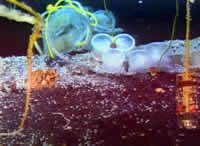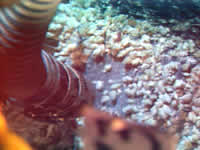|
Teacher Logbook - NOAA Ship Ron Brown
| |

Bacterial
traps are pictured here at Marker-33, amidst several experiments.
There are 2 bacterial trap packages in this image (3 round cylinders/package
- front center). Other experiments shown are an iron-osmoanalyzer
(large white-yellow object to the left of the traps) and a moored
temperature recorder (lower right).

The suction sampler is used to collect
macro and micro biological samples,
as
well as sediment and small rock chips. Limpets from the area of the
'98
lava
flow are being sucked up through the hose and deposited in bottles
on the
ROV. |
|
Jeff Goodrich's Sealog:
Axial Volcano: 1998 lava flow
July 20, 2001
Plop. Another
bac-trap in the bio-box. Nice shot Big Keith! (photo right) Microbial
communities abound and form the base of the food chain at hydrothermal
vents. Microbiologists Craig Moyer and Jeff Engebretson capture these
critters in special plexi-glass containers with 200-micron nitex screens.
They are designed to be placed over relatively cool diffuse vents and
transmit hydrothermal fluid through them. Inside the traps are fiberglass
strings to provide substrate for optimal bacterial growth. There is no
grazing pressure from the various types of worms that inhabit these areas.
The traps pick up very different microbial communities than the ROPOS's
slurp sampler, a vacuum system that sucks up bottom substrate and deposits
it in bottles. According to Jeff the bac-traps are a "bacterial utopia."
Once the
slimy traps are brought up to the ship they are immediately frozen
in
dry ice. Back at their Western Washington University lab they will extract,
then
identify DNA patterns at different vent sites to compile community
fingerprints.
Very little is understood about how these organisms exist as a community.
Ultimately they will cluster each venting area based on its bacterial
community.
Craig and Jeff are attempting to determine the influence of macrofauna
(larger
animals) and vent chemistry on supporting a particular microbial community.
Also, they are trying to figure out how much bacterial communities alter
the
chemistry of the vent fluids and how they aid in the weathering of ocean
floor
rocks. Since microbial communities are extremely old they may provide
some
insight into the field of astro-biology.
|

